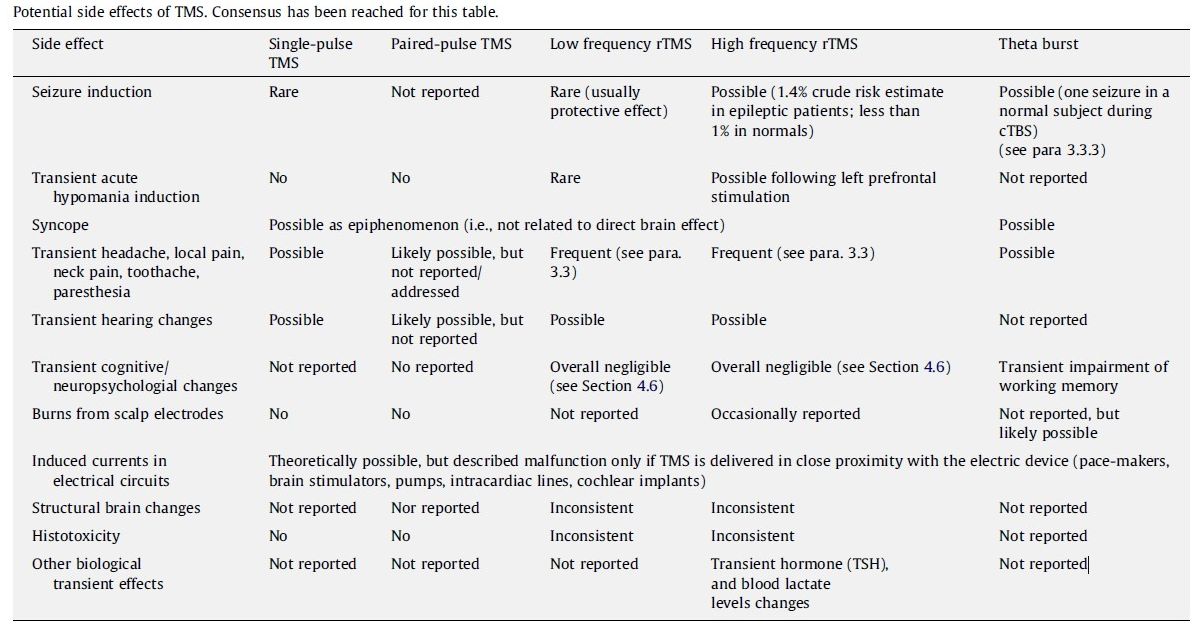Ethical Considerations
(a) Obtain subjects’ informed consent, disclosing all known and potential risks of rTMS. (b) Ensure that the potential benefit of rTMS out-weighs the risk. (c) Demand equal distribution of the burdens and benefits of rTMS among study populations. (d) Stratify rTMS studies according to the following criteria: Class 1. Experimental treatment of disease in patients, with potential direct clinical benefit and subject protection determined by well-defined clinical goals and risks of alternative treatments. Class 2. Development of treatment, safety studies, or improved understanding of disease in patients or normal subjects, with outstanding potential clinical value and maximum subject protection. Class 3. Basic research in patients or normal subjects, with outstanding potential scientific value and maximum subject protection. (e) Observe all reasonable safety precautions in all studies, but some significant adverse effects are acceptable in class 1 studies, and must be anticipated.
Stimulation Parameters
Use subthreshold rTMS with caution; its safety has not been systematically investigated. For class 2 and class 3 studies, allow intervals of at least 5 s between 20 Hz trains with intensities of up to 1.1´ the MEP threshold. Longer intervals are required for higher intensities and frequencies.
Physiological monitoring
(a) Continuously monitor the EMG from hand muscles contralateral to the stimulation site for elicited MEPs when areas other than the M1 are stimulated or when the M1 receives subthreshold stimulation. Under these conditions, the presence of MEPs indicates intracortical spread of excitation or a decrease in the threshold. For rTMS stimulation of the M1 at intensities above the threshold, monitor sets of contralateral arm muscles for evidence of the intracortical spread of excitation. (b) Monitor the EEG when and if it becomes if feasible, and if electrode heating can be avoided. (c) During stimulation, have the subject observed by a physician who is experienced in the use of rTMS. (d) Consider videotaping high-risk studies.
Neuropsychological monitoring.
(a) In all classes of rTMS studies, monitor subjects for neuropsychological effects whenever possible until the safety of the specific regimen is established. The fol-lowing domains are suggested for testing: simple and choice reaction time, ability to inhibit automatic responses (e.g., a Stroop-type task), ability to retrieve and ex-press symbols (e.g., word fluency tests) verbal and nonverbal working and episod-ic memory, retrieval of pre-rTMS information, executive functions (e.g., judgment, insight, reasoning), mood state (subject’s self-report),and overall functional state (observer rating scale for mood and various other factors). (b) Establish a policy on protection of subjects who might experience significant neuropsychological changes after rTMS.
The rTMS Team
(a) Perform rTMS only in a medical setting where a skilled medical team and life-support equipment are available. (b) Have a qualified clinical neurophysiologist to monitor the recording and interpret rTMS data. (c) Make certain that a physician or nurse skilled in seizure management is present in the rTMS laboratory during and immediately after rTMS.
Medical Management of Seizures
(a) Ensure that the rTMS laboratory has a place where the subject can lie in the event of a seizure or other medical emergency. (b) Familiarize persons in the rTMS laboratory with the location of life-support equipment and the means of summoning help. (c) Manage seizures according to the A-B-C rule: airway-breathing-circulation. (d) Obtain venous access as soon as possible. (e) Use anti-epileptic drugs only under the guidance of an experienced physician and only to treat seizures lasting more than several minutes, seizures resulting in hypoxia or acidosis, or repeated seizures.
Management of psychosocial consequences of seizures
a) Provide medical and psychological support to patients and normal subjects who have rTMS-induced seizures, and counsel them that they are not at a greater risk than before for further seizures. (b) Minimize the potential social impact of a sei-zure by medical documentation. (c) Inform appropriate subjects that a seizure induced by rTMS may affect employability and insurability. (d) When appropriate, provide additional documentary support of a healthy subject’s claim that a provoked seizure carries no adverse prognosis.
Contraindications to rTMS
(a) Absolute: metal in cranium, intracardiac lines, increased intracranial pressure. (b) Relative: pregnancy, childhood, heart disease, cardiac pacemaker, medication pump, tricyclic anti-depressants, neuroleptics, family history of epilepsy.




